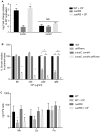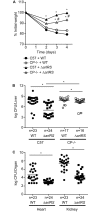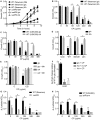The Two-Component System ArlRS and Alterations in Metabolism Enable Staphylococcus aureus to Resist Calprotectin-Induced Manganese Starvation
- PMID: 27902777
- PMCID: PMC5130280
- DOI: 10.1371/journal.ppat.1006040
The Two-Component System ArlRS and Alterations in Metabolism Enable Staphylococcus aureus to Resist Calprotectin-Induced Manganese Starvation
Abstract
During infection the host imposes manganese and zinc starvation on invading pathogens. Despite this, Staphylococcus aureus and other successful pathogens remain capable of causing devastating disease. However, how these invaders adapt to host-imposed metal starvation and overcome nutritional immunity remains unknown. We report that ArlRS, a global staphylococcal virulence regulator, enhances the ability of S. aureus to grow in the presence of the manganese-and zinc-binding innate immune effector calprotectin. Utilization of calprotectin variants with altered metal binding properties revealed that strains lacking ArlRS are specifically more sensitive to manganese starvation. Loss of ArlRS did not alter the expression of manganese importers or prevent S. aureus from acquiring metals. It did, however, alter staphylococcal metabolism and impair the ability of S. aureus to grow on amino acids. Further studies suggested that relative to consuming glucose, the preferred carbon source of S. aureus, utilizing amino acids reduced the cellular demand for manganese. When forced to use glucose as the sole carbon source S. aureus became more sensitive to calprotectin compared to when amino acids are provided. Infection experiments utilizing wild type and calprotectin-deficient mice, which have defects in manganese sequestration, revealed that ArlRS is important for disease when manganese availability is restricted but not when this essential nutrient is freely available. In total, these results indicate that altering cellular metabolism contributes to the ability of pathogens to resist manganese starvation and that ArlRS enables S. aureus to overcome nutritional immunity by facilitating this adaptation.
Conflict of interest statement
The authors have declared that no competing interests exist.
Figures







Similar articles
-
Disruption of Glycolysis by Nutritional Immunity Activates a Two-Component System That Coordinates a Metabolic and Antihost Response by Staphylococcus aureus.mBio. 2019 Aug 6;10(4):e01321-19. doi: 10.1128/mBio.01321-19. mBio. 2019. PMID: 31387906 Free PMC article.
-
A Manganese-independent Aldolase Enables Staphylococcus aureus To Resist Host-imposed Metal Starvation.mBio. 2023 Feb 28;14(1):e0322322. doi: 10.1128/mbio.03223-22. Epub 2023 Jan 4. mBio. 2023. PMID: 36598285 Free PMC article.
-
The Sensor Histidine Kinase ArlS Is Necessary for Staphylococcus aureus To Activate ArlR in Response to Nutrient Availability.J Bacteriol. 2021 Nov 19;203(24):e0042221. doi: 10.1128/JB.00422-21. Epub 2021 Oct 4. J Bacteriol. 2021. PMID: 34606376 Free PMC article.
-
Competition for Manganese at the Host-Pathogen Interface.Prog Mol Biol Transl Sci. 2016;142:1-25. doi: 10.1016/bs.pmbts.2016.05.002. Epub 2016 Jun 20. Prog Mol Biol Transl Sci. 2016. PMID: 27571690 Review.
-
Metal ion acquisition in Staphylococcus aureus: overcoming nutritional immunity.Semin Immunopathol. 2012 Mar;34(2):215-35. doi: 10.1007/s00281-011-0294-4. Epub 2011 Nov 3. Semin Immunopathol. 2012. PMID: 22048835 Free PMC article. Review.
Cited by
-
Coordination of CcpA and CodY Regulators in Staphylococcus aureus USA300 Strains.mSystems. 2022 Dec 20;7(6):e0048022. doi: 10.1128/msystems.00480-22. Epub 2022 Nov 2. mSystems. 2022. PMID: 36321827 Free PMC article.
-
Key players in the regulation of iron homeostasis at the host-pathogen interface.Front Immunol. 2023 Oct 24;14:1279826. doi: 10.3389/fimmu.2023.1279826. eCollection 2023. Front Immunol. 2023. PMID: 37942316 Free PMC article. Review.
-
The Staphylococcus aureus ArlRS two-component system regulates virulence factor expression through MgrA.Mol Microbiol. 2020 Jan;113(1):103-122. doi: 10.1111/mmi.14404. Epub 2019 Nov 6. Mol Microbiol. 2020. PMID: 31618469 Free PMC article.
-
Transition Metal Sequestration by the Host-Defense Protein Calprotectin.Annu Rev Biochem. 2018 Jun 20;87:621-643. doi: 10.1146/annurev-biochem-062917-012312. Annu Rev Biochem. 2018. PMID: 29925260 Free PMC article. Review.
-
Whole genome sequence and comparative genome analyses of multi-resistant Staphylococcus warneri GD01 isolated from a diseased pig in China.PLoS One. 2020 May 22;15(5):e0233363. doi: 10.1371/journal.pone.0233363. eCollection 2020. PLoS One. 2020. PMID: 32442199 Free PMC article.
References
-
- CDC. Antibiotic Resistance Threats in the United States, 2013: Centers for Disease Control and Prevention; 2013. [cited 2013].
-
- WHO. Antimicrobial Resistance Global Report on Surveillance: World Health Organization; 2014. [cited 2014].
-
- Andreini C, Bertini I, Cavallaro G, Holliday GL, Thornton JM. Metal ions in biological catalysis: from enzyme databases to general principles. Journal of biological inorganic chemistry: JBIC: a publication of the Society of Biological Inorganic Chemistry. 2008;13(8):1205–18. - PubMed
MeSH terms
Substances
Grants and funding
LinkOut - more resources
Full Text Sources
Other Literature Sources
Medical
Molecular Biology Databases

